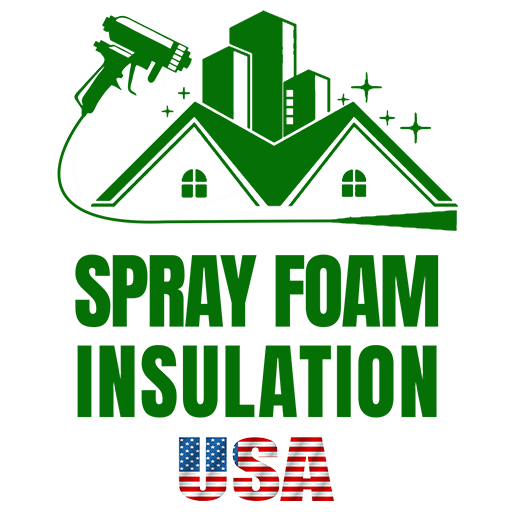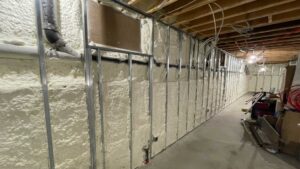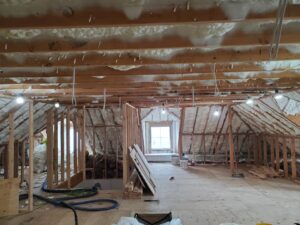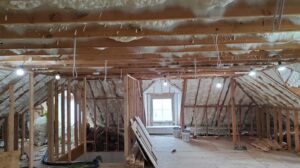Is foam insulation safe? This is a question many homeowners and business owners in NY and NJ ask as they search for energy-efficient and eco-friendly insulation solutions. The quick answer is: Yes, foam insulation is safe when installed correctly by professional installers.
Foam insulation, whether open-cell or closed-cell, has become a go-to choice for those looking to enhance their property’s energy efficiency and comfort. However, with its increasing popularity, safety concerns regarding chemical exposure and indoor air quality have also surfaced.
Foam insulation works by expanding and hardening into a solid mass, effectively filling gaps and creating an air-tight seal. This can significantly reduce energy bills and contribute to a more consistent indoor temperature year-round. Yet, the safety of foam insulation primarily hinges on proper installation and curing. If not installed correctly, there’s a risk of continuous off-gassing, which can introduce harmful chemicals into your living space.
Another factor to consider is the environmental impact of foam insulation. Though it offers excellent energy efficiency, the end-of-life disposal of spray foam is not as green, with the majority ending up in landfills.
We’ll guide you through the essentials of foam insulation, addressing safety concerns, installation best practices, and sustainable options available. Our goal is to provide you with the information needed to make an informed decision on whether foam insulation is the right choice for your property.
The Basics of Foam Insulation
When it comes to insulating your home, foam insulation is a popular choice for many. But what exactly is foam insulation, and what are the different types available? Let’s break it down into simple terms.
Types of Foam Insulation
Foam insulation mainly comes in two types: open cell and closed cell. Each has its unique properties and uses, making them suitable for different applications.
-
Open Cell Foam: This type of foam is softer and more flexible because it has tiny cells that are not completely closed. Open cell foam is great for sound reduction because it can absorb sound waves. However, it’s not as dense or moisture-resistant as closed cell foam, making it less ideal for areas prone to water leaks.
-
Closed Cell Foam: As the name suggests, the cells in this foam are completely closed, making the foam denser and more rigid. This type of foam is excellent for areas requiring moisture resistance and added structural support. It’s more effective at blocking water and air, making it suitable for both indoor and outdoor applications.

Open Cell vs Closed Cell Foam
Choosing between open cell and closed cell foam depends on your specific needs:
- Sound Reduction: If you’re looking to reduce noise, open cell foam is the better choice.
- Moisture Resistance: For areas exposed to water or high humidity, closed cell foam offers superior protection.
- Structural Support: Closed cell foam can also provide additional strength to your building structure.
- Budget Considerations: Open cell foam is generally less expensive than closed cell foam, making it a cost-effective option for large areas.
In summary, the type of foam insulation you choose will depend on the specific requirements of your project, whether it’s soundproofing, moisture resistance, structural support, or budget constraints. Understanding the basics of foam insulation is the first step in making an informed decision for your home’s insulation needs.
Next, we’ll dive into the health and safety concerns associated with foam insulation, ensuring you’re fully informed of the potential risks and how to mitigate them.
Health and Safety Concerns
When it comes to installing foam insulation in your home, safety is a top priority. Let’s break down the key concerns and what you need to know to keep your home and family safe.
Toxic Chemicals and VOCs
Foam insulation, like many building materials, contains chemicals. Some of these can release volatile organic compounds (VOCs) during and after installation. VOCs can affect indoor air quality and may cause discomfort or health issues for some people.
Isocyanate
A key ingredient in many foam insulation products is isocyanate, especially in spray polyurethane foam (SPF). Isocyanate can cause irritation to the skin, eyes, and respiratory system. Prolonged exposure can lead to sensitization, which means even small amounts can trigger allergic reactions.
Proper Curing
Curing is the process where the chemicals in foam insulation react to create the final product. This process can release chemicals into the air. It’s crucial that foam insulation is given the proper time to cure, reducing potential exposure to these chemicals.
Off-Gassing
After foam insulation is applied, it can “off-gas,” releasing chemicals into the air as it cures. This process can last for hours or days, depending on the product and conditions. Ensuring good ventilation during and after installation can help minimize exposure to off-gassing.
Respiratory Issues
Inhalation of chemicals from foam insulation, especially before it has fully cured, can lead to respiratory issues. This is a particular concern for installers who may be exposed to high levels of chemicals without proper protective gear.
Eye Irritation and Skin Sensitivity
Direct contact with uncured foam insulation can irritate the skin and eyes. Wearing protective gear, like gloves and goggles, during installation can help prevent these issues.
Ensuring foam insulation is safe involves understanding these potential health and safety concerns. By choosing licensed contractors who use the right protective gear, ensuring proper ventilation, and allowing for adequate curing time, you can enjoy the benefits of foam insulation without compromising on safety.
Next, we’ll explore the environmental impact and sustainability of foam insulation, including eco-friendly options and how insulation can contribute to energy efficiency in your home.
Installation and Proper Use
When it comes to installing foam insulation, doing it the right way is key to keeping your home safe and comfortable. Let’s break down the essentials: finding the right people for the job, suiting up properly, making sure the air in your home stays fresh, waiting for the foam to set, and keeping the air inside clean.
Licensed Contractors
Why it matters: Hiring licensed contractors is like choosing a pilot for your flight. You want someone who knows what they’re doing, has been trained properly, and can handle any turbulence along the way.
- Look for experience: Contractors should have a solid track record of installing foam insulation.
- Check for licenses and certifications: This ensures they’re up to date on the latest safety and installation techniques.
Protective Gear
Safety first: Installers should wear protective gear to shield themselves from chemicals in the foam. This includes:
- Respirators to avoid breathing in fumes
- Goggles to protect the eyes
- Gloves and full-body suits to keep skin safe
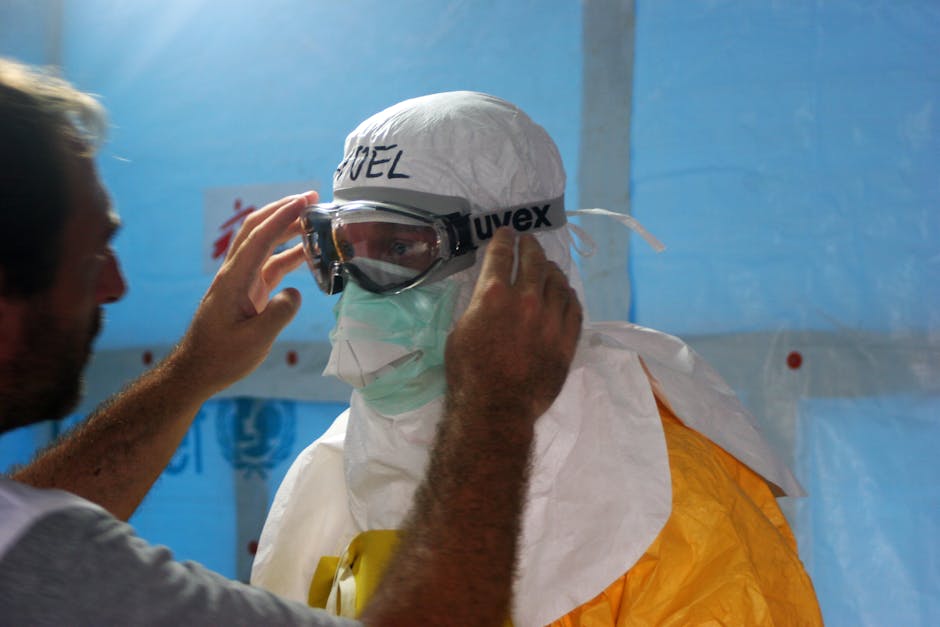
Ventilation
Keep it breezy: Proper ventilation is crucial during and after installation. It helps clear out any fumes and keeps the air in your home safe to breathe.
- Open windows and doors: This helps air circulate and removes any harmful vapors.
- Use fans: They can help speed up the process of getting fresh air in and pushing bad air out.
Curing Time
Patience is key: Foam insulation needs time to cure, or harden. During this time, it can release chemicals into the air.
- Wait it out: Typically, you should stay out of the area for at least 24 hours. However, this can vary based on the type of foam and the conditions in your home.
- Follow the pros’ advice: Your contractor will tell you how long to wait before it’s safe to come back.
Indoor Air Quality
Keep it clean: Even after the foam has cured, keep an eye on your home’s air quality.
- Regular checks: Use air quality monitors to keep tabs on the levels of chemicals in the air.
- Professional testing: Consider having your air tested by experts, especially if you notice any unusual smells or health symptoms.

In summary, installing foam insulation safely is all about choosing the right team, gearing up, keeping the air clear, being patient, and making sure your home’s air stays clean. With these steps, you can enjoy the comfort and efficiency of foam insulation without worry.
Next, we’ll dive into the environmental impact and sustainability of foam insulation. We’ll look at eco-friendly options and discuss how the right insulation can actually help your home use less energy.
Environmental Impact and Sustainability
When it comes to insulating our homes, we all want to make choices that are not only good for us but also good for the planet. Foam insulation, like any other product, has its environmental impacts, but there are eco-friendly options and practices that can help minimize these effects.
Eco-Friendly Options:
The good news is that innovations in foam insulation technology have led to the development of products with a smaller environmental footprint. For instance, some foam insulations now use hydrofluoroolefin (HFO) blowing agents, which have a significantly lower Global Warming Potential (GWP) compared to their predecessors. This means they contribute less to climate change.
Ozone Depleting Substances:
Historically, certain foam insulations used blowing agents that were harmful to the ozone layer. However, thanks to global agreements and regulations, such as the Montreal Protocol, these substances are being phased out. Today, you can find foam insulation options that are free from ozone-depleting chemicals, making them a better choice for the environment.
Greenhouse Gases:
It’s crucial to consider the GWP of the blowing agents used in foam insulation. As mentioned, newer formulations aim to reduce this impact, aligning with efforts to combat climate change. By choosing products with lower GWP, you’re contributing to a reduction in greenhouse gas emissions.
Energy Efficiency:
One of the most compelling environmental arguments for foam insulation is its ability to significantly reduce energy consumption in buildings. By creating a more airtight space, foam insulation minimizes the energy required for heating and cooling, which can lead to lower carbon emissions overall. This efficiency not only helps the planet but can also save you money on energy bills.
In conclusion, while foam insulation has faced criticism for its environmental impact, advancements in technology and awareness have led to the development of more sustainable options. By choosing products with eco-friendly blowing agents, avoiding ozone-depleting substances, and considering the overall energy efficiency benefits, you can make a choice that’s good for your home and the earth.
As we continue our journey to create comfortable and efficient living spaces, it’s clear that the materials we choose play a crucial role. Let’s keep these considerations in mind as we move forward, always striving for a balance between our needs and the health of our planet.
Next, we’ll address some common misconceptions about foam insulation to help you make the most informed decisions for your home.
Addressing Common Misconceptions
When it comes to foam insulation, there are a few myths that can muddy the waters. Let’s clear up some common misconceptions to help you understand what’s really going on.
Airtight Homes
Myth: Foam insulation seals your home too well, making it airtight and trapping bad air inside.
Fact: While foam insulation does create a more sealed environment, this isn’t a bad thing. It prevents unwanted air leaks, keeping your home more comfortable and energy-efficient. However, a well-insulated home still needs good ventilation. Solutions like energy recovery ventilators (ERVs) can ensure that your home remains not only airtight but also has healthy air circulation.
Moisture Traps
Myth: Sealing your home with foam insulation traps moisture, leading to mold and structural damage.
Fact: Foam insulation can actually help manage moisture in your home. By creating a tighter seal, it reduces the likelihood of condensation and moisture buildup, which are key contributors to mold growth. The key is proper installation. When done correctly, moisture-related issues can be significantly minimized.
Longevity
Myth: Foam insulation breaks down quickly, losing its effectiveness over time.
Fact: One of the benefits of foam insulation is its durability and longevity. It tends to last longer than traditional insulation materials, maintaining its insulating properties for years. As long as it’s correctly installed, you shouldn’t have to worry about it degrading or needing frequent replacement.
Removal Challenges
Myth: Once you’ve installed foam insulation, it’s almost impossible to remove, making future renovations a nightmare.
Fact: It’s true that removing foam insulation is more challenging than other types of insulation. However, it’s not impossible. The permanence of foam insulation should be seen as a benefit, reflecting its durability and the long-term stability it provides to your home’s temperature regulation. For renovations, working with a professional can help navigate any adjustments or removals if absolutely necessary.
In summary, foam insulation is a safe and effective way to improve your home’s energy efficiency and comfort. It’s important to work with licensed professionals who can ensure it’s installed correctly, addressing any potential issues like ventilation or moisture management upfront. By debunking these common myths, we hope you feel more confident in making informed decisions about insulating your home.
Remember that every home is unique. What works best for one might not be the ideal solution for another. Keep asking questions, and let’s strive for homes that are not only comfortable and efficient but also healthy and safe for everyone.
Frequently Asked Questions about Foam Insulation
When it comes to foam insulation, there are a lot of questions homeowners have. Let’s dive into some of the most common ones to help you make informed decisions.
Is Foam Insulation Safe for Homes?
Yes, foam insulation is safe for homes when it’s installed correctly. The key factors that ensure its safety include proper installation by trained professionals, adequate ventilation during the curing process, and choosing products that meet high-quality standards.
Spray foam insulation, when fully cured, is stable and does not emit harmful chemicals. However, during application and curing, it can release volatile organic compounds (VOCs) and other substances. That’s why it’s crucial not to stay in the home during and immediately after installation until the product has fully cured, typically within 24 to 72 hours.
Where Should You Not Use Spray Foam Insulation?
Spray foam insulation is versatile but there are a few places where it might not be the best choice:
- Directly on electrical boxes or wiring: This could potentially cause overheating.
- In areas with poor ventilation: Without proper air exchange, the off-gassing can’t dissipate effectively.
- Over damp or wet surfaces: Moisture can prevent the foam from adhering properly and curing.
Always consult with a professional to assess the specific needs and challenges of your home.
What is the Safest Insulation to Use?
The “safest” insulation depends on your specific needs, including your home’s design, climate, and any sensitivities you might have to materials. However, spray foam insulation, when properly installed, is considered safe and offers excellent insulation properties, air sealing, and can contribute to the overall energy efficiency of your home.
For those concerned about chemicals, there are eco-friendly spray foam options that use water or other more environmentally friendly blowing agents instead of chemicals that deplete the ozone layer or contribute to global warming.
In conclusion, foam insulation is a safe, effective way to insulate your home, provided it’s installed correctly and with the right materials. Always work with licensed, experienced professionals who can guide you to the best solution for your specific situation. The goal is to make your home more comfortable, energy-efficient, and safe for your family.
As we continue to explore insulation options, it’s important to weigh the benefits against any potential drawbacks, and always aim for solutions that enhance both the comfort and safety of your living space.
Conclusion
In wrapping up our journey through foam insulation, it’s clear that the safety and effectiveness of spray foam insulation hinge on correct installation and informed choices. At Spray Foam Insulation USA, we are committed to ensuring that your home benefits from the highest quality insulation solutions that are not only effective but also safe for your family and the environment.
Spray foam insulation has emerged as a standout choice for homeowners seeking to enhance their home’s energy efficiency and comfort. Its ability to seal homes from air and moisture infiltration, coupled with its high R-value, makes it an appealing option for those looking to reduce their energy costs and environmental footprint.
However, we recognize that safety concerns, particularly around the application process and the chemicals involved, can be a significant consideration for many. That’s why we emphasize the importance of professional installation by licensed contractors who use the right protective gear and adhere to strict safety protocols to ensure the insulation is applied safely and correctly.
Proper ventilation and curing time are crucial to mitigate potential off-gassing and ensure the insulation does not compromise indoor air quality. We are dedicated to guiding our customers through this process, ensuring a safe, efficient, and worry-free installation.
Moreover, we are proud to offer eco-friendly options that align with our commitment to sustainability. By choosing products with a low environmental impact, we help reduce greenhouse gas emissions and support a healthier planet.
In addressing common misconceptions, we’ve highlighted the importance of understanding the nuances of spray foam insulation, including its longevity, the potential for moisture traps, and the ease of removal when done correctly. Our goal is to provide you with all the information you need to make an informed decision that meets your specific needs.
For those considering foam insulation, we invite you to explore our services further at Spray Foam Insulation USA. Here, you’ll find comprehensive solutions that prioritize safety, efficiency, and sustainability. Whether you’re upgrading existing walls or embarking on new construction, our team is here to support you every step of the way.
Choosing the right insulation is about balancing benefits with potential drawbacks, and at Spray Foam Insulation USA, we’re here to ensure that balance tips in favor of comfort, safety, and environmental responsibility. Let’s work together to create a more sustainable, comfortable, and energy-efficient home for you and your family.

